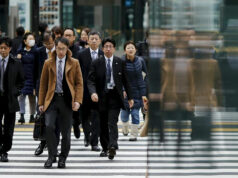Inflation likely extended uptrend
INFLATION likely continued to pick up in December due to seasonal demand amid the holidays, as well as diminishing base effects from 2018’s highs, according to analysts.
A BusinessWorld poll of 13 economists last week yielded a median estimate of 2.1% for December headline inflation. If realized, the rate will be near the lower end of the central bank’s forecast range of 1.8-2.6% for the month.
This compares with the 1.3% print logged in November, which was the first uptick following five straight months of slowing inflation — even hitting a low of 0.8% in October — due largely to base effects.
In the first 11 months of 2019, the overall rise in prices of widely used goods averaged 2.5%, above the midpoint of the BSP’s 2-4% target for the year.
The central bank is forecasting a full-year inflation average of 2.4%. Inflation averaged at 5.2% in 2018.
The Philippine Statistics Authority will release December and full-year 2019 inflation data on Jan. 7.
Economists said prices likely climbed due to holiday spending.
“This uptick is mainly from a significantly higher consumption demand due to the holiday celebrations. Consumers ate out more and they tend to spend more for traditional gift giving and other merry-making activities,” UnionBank of the Philippines, Inc. Chief Economist Ruben Carlo O. Asuncion said in an e-mail.
“Prices of some food items also seasonally went up due to the Christmas holiday season… especially ham, other alternative meat products such as chicken and beef, fish, though some month-on-month upward adjustment in food prices already took place in November,” Rizal Commercial Banking Corp. Chief Economist Michael L. Ricafort said.
For his part, Security Bank Corp. Chief Economist Robert Dan J. Roces said prices of some commodities climbed in December.
“We see an uptick in prices for selected food items as well as alcoholic beverages and tobacco, and upward price adjustments in electricity rates (due to a higher generational charge) plus uptrends in diesel, gasoline, and kerosene prices,” Mr. Roces said in an e-mail.
Manila Electric Co. (Meralco) said last month the generation charge for December inched up to P5.1967 per kilowatt-hour (/kWh), higher by P0.165/kWh from the November rate.
With this, power users in Metro Manila and surrounding areas likely saw their December bills increase by P0.3044/kWh or an additional P61-152.20 to their average monthly bills, Meralco said.
Bank of the Philippine Islands Lead Economist Emilio S. Neri, Jr. said inflation likely picked up as “global oil prices last month were around 20% higher versus December 2018.”
Analysts also cited inflationary pressure from weather-related disruptions.
“Despite lower rice prices from a year ago weighing on inflationary pressures, an uptick in fuel inflation and possible supply-side disruptions from adverse weather conditions should see inflation climb further in December,” Thatchinamoorthy Krshnan, an economist at Oxford Economics, said.
Two typhoons, Tisoy and Ursula, hit the country in December. The National Disaster Risk Reduction and Management Council last week said damage to infrastructure and agriculture caused by Typhoon Ursula has hit P1.194 billion so far.
Meanwhile, the Department of Agriculture last month said agricultural damage from Typhoon Tisoy was estimated at P3.67 billion. — L.W.T. Noble




